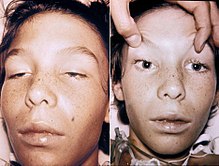| Botulism | |
|---|---|
 | |
| A 14-year-old boy with botulism, characterised by weakness of the eye muscles and the drooping eyelids shown in the left image, and dilated and non-moving pupils shown in the right image. This youth was fully conscious. | |
| Pronunciation | |
| Specialty | Infectious disease, gastroenterology |
| Symptoms | Weakness, trouble seeing, feeling tired, trouble speaking |
| Complications | Respiratory failure |
| Usual onset | 12 to 72 hours |
| Duration | Variable |
| Causes | Clostridium botulinum |
| Diagnostic method | Finding the bacteria or their toxin |
| Differential diagnosis | Myasthenia gravis, Guillain–Barré syndrome, Amyotrophic lateral sclerosis, Lambert Eaton syndrome |
| Prevention | Proper food preparation, no honey for children younger than one |
| Treatment | Antitoxin, antibiotics, mechanical ventilation |
| Prognosis | ~7.5% risk of death |
Botulism is a rare and potentially fatal illness caused by botulinum toxin, which is produced by the bacterium Clostridium botulinum. The disease begins with weakness, blurred vision, feeling tired, and trouble speaking. This may then be followed by weakness of the arms, chest muscles, and legs. Vomiting, swelling of the abdomen, and diarrhea may also occur. The disease does not usually affect consciousness or cause a fever.
Botulism can occur in several ways. The bacterial spores which cause it are common in both soil and water and are very resistant. They produce the botulinum toxin when exposed to low oxygen levels and certain temperatures. Foodborne botulism happens when food containing the toxin is eaten. Infant botulism instead happens when the bacterium develops in the intestines and releases the toxin. This typically only occurs in children less than one year old, as protective mechanisms against development of the bacterium develop after that age. Wound botulism is found most often among those who inject street drugs. In this situation, spores enter a wound, and in the absence of oxygen, release the toxin. The disease is not passed directly between people. Its diagnosis is confirmed by finding the toxin or bacteria in the person in question.
Prevention is primarily by proper food preparation. The toxin, though not the spores, is destroyed by heating it to more than 85 °C (185 °F) for longer than five minutes. The clostridial spores can be destroyed in an autoclave with moist heat (120°C/ 250°F for at least 15 minutes) or dry heat (160°C for 2 hours) or by irradiation. The spores of group I strains are inactivated by heating at 121°C (250°F) for 3 minutes during commercial canning. Spores of group II strains are less heat-resistant, and they are often damaged by 90°C (194°F) for 10 minutes, 85°C for 52 minutes, or 80°C for 270 minutes; however, these treatments may not be sufficient in some foods.[1] Honey can contain the organism, and for this reason, honey should not be fed to children under 12 months. Treatment is with an antitoxin. In those who lose their ability to breathe on their own, mechanical ventilation may be necessary for months. Antibiotics may be used for wound botulism. Death occurs in 5 to 10% of people. Botulism also affects many other animals. The word is from Latin botulus, meaning 'sausage'.
- ^ Center for Food Security and Public Health Iowa State University (19 February 2024). "Botulism" (PDF).